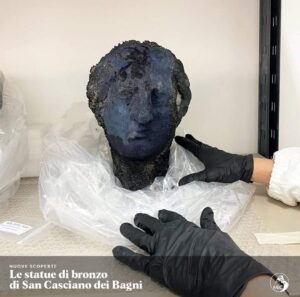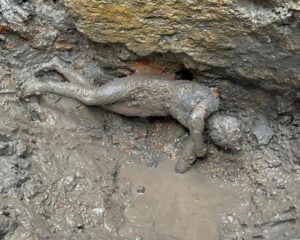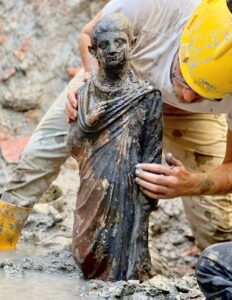
Over 20 bronze statues in perfect condition, votive offerings and other objects, as well as five thousand gold, silver and bronze coins. These are the exceptional new discoveries returned by the excavation campaign at the Etruscan-Roman sanctuary connected to the ancient sacred pool of the Bagno Grande thermo-mineral spring in San Casciano dei Bagni![]() , in the province of Siena
, in the province of Siena![]() . Started in 2019, the excavation promoted by the Ministry of Culture and the Tuscan municipality under the coordination of Prof. Jacopo Tabolli of the University for Foreigners of Siena led to these extraordinary new findings in the first weeks of October. In San Casciano, thanks to recent MiC funding, a new museum will be built to house the finds.
. Started in 2019, the excavation promoted by the Ministry of Culture and the Tuscan municipality under the coordination of Prof. Jacopo Tabolli of the University for Foreigners of Siena led to these extraordinary new findings in the first weeks of October. In San Casciano, thanks to recent MiC funding, a new museum will be built to house the finds.
‘A discovery that will rewrite history and on which more than 60 experts from all over the world are already at work,’ says the Etruscologist in charge of the excavation, Prof. Jacopo Tabolli. This is how, 50 years after the discovery in 1972 of the famous ‘Riace bronzes’, the history of ancient Etruscan and Roman bronze statuary is being rewritten in San Casciano dei Bagni. The Tuscan site is the largest deposit of bronze statues from the Etruscan and Roman age ever discovered in ancient Italy and one of the most significant in the entire Mediterranean: unparalleled especially because, until now, mainly terracotta statues were known from this period.

“An exceptional find, which confirms once again that Italy is a country of immense and unique treasures. The stratification of different civilisations is unique in Italian culture,” says Minister of Culture Gennaro Sangiuliano who, just yesterday, on one of his first visits outside Rome, was in Grosseto at the laboratory of the Central Institute for Restoration, where study activities and the first interventions on the bronzes are underway. “I wanted to personally congratulate the archaeologists and the research team,” the Minister concluded. “The study and valorisation of this treasure will be a further opportunity for the spiritual growth of our culture and for the revitalisation of lesser-known territories for international tourism, but also as a flywheel for the nation’s cultural industry.
“It is the most important discovery since the Riace Bronzes and certainly one of the most significant bronze finds ever made in the history of the ancient Mediterranean,” comments Massimo Osanna, Director General of the Italian museums, who has just approved the purchase of the 16th-century palace that will house the wonders returned from Bagno Grande in the village of San Casciano, a museum to which a real archaeological park will be added in the future.
“The importance of the method used in this excavation is also represented by the collaboration between specialists from all disciplines: from architects to geologists, from archaeobotanists to epigraphy and numismatics experts,” explains MiC Director of Archaeology, Fine Arts and Landscape, Luigi La Rocca.

“This discovery offers San Casciano an opportunity that is not only cultural and touristic, but a real chance for rebirth,” says the mayor of the Tuscan municipality, Agnese Carletti.
“A new museum, which will house the exceptional statues, and an archaeological park will be created in San Casciano. Two new places that will be for the area a real engine of development that will add to the already exciting presence of young archaeologists from all over the world who, thanks to this excavation, are repopulating the town now for many months of the year”.
The San Casciano bronzes depict the deities worshipped at the sacred site, together with the organs and anatomical parts for which the healing intervention of the deity through thermal waters was sought. Effigies of Hygieia and Apollo have re-emerged from the hot mud in recent weeks, as well as a bronze reminiscent of the famous Arringatore, discovered in Perugia and in the historical collections of the National Archaeological Museum in Florence.

The exceptional state of preservation of the statues within the hot spring water has also made it possible to preserve marvellous inscriptions in Etruscan and Latin that were engraved before they were made. In the inscriptions one can read the names of powerful Etruscan families in the territory of inner Etruria, from the Velimna of Perugia to the Marcni known in the Sienese countryside. Alongside onomastics and dedicatory forms in Etruscan we find inscriptions in Latin, which also mention the aquae calidae, the hot springs of Bagno Grande, where the statues were placed.
Most of these masterpieces of antiquity date from between the 2nd century B.C. and the 1st century A.D., a historical period of important transformations in ancient Tuscany, in the transition between the Etruscans and Romans. In this era of great conflicts between Rome and the Etruscan cities, but also of struggles within the social fabric of the Urbe, in the sanctuary of the Bagno Grande the noble Etruscan families, at a time when Rome’s expansion also meant cultural osmosis,
dedicated statues to sacred water. An absolutely unique multicultural and multilingual context of peace, surrounded by political instability and war.
